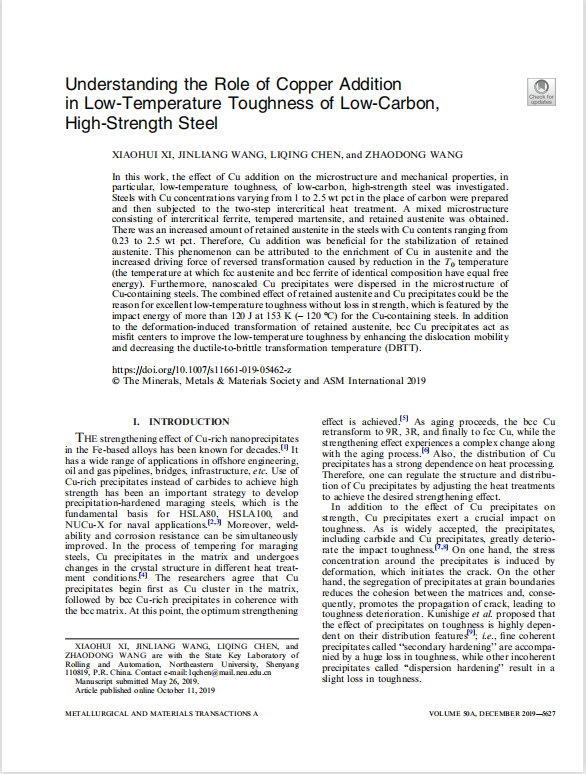名称 : Understanding the Role of Copper Addition in Low-Temperature Toughness of Low-Carbon, High-Strength Steel
发表日期 : 2019-10-11
摘要 : In this work, the effffect of Cu addition on the microstructure and mechanical properties, in particular, low-temperature toughness, of low-carbon, high-strength steel was investigated. Steels with Cu concentrations varying from 1 to 2.5 wt pct in the place of carbon were prepared and then subjected to the two-step intercritical heat treatment. A mixed microstructure consisting of intercritical ferrite, tempered martensite, and retained austenite was obtained. There was an increased amount of retained austenite in the steels with Cu contents ranging from 0.23 to 2.5 wt pct. Therefore, Cu addition was benefificial for the stabilization of retained austenite. This phenomenon can be attributed to the enrichment of Cu in austenite and the increased driving force of reversed transformation caused by reduction in the T0 temperature (the temperature at which fcc austenite and bcc ferrite of identical composition have equal free energy). Furthermore, nanoscaled Cu precipitates were dispersed in the microstructure of Cu-containing steels. The combined effffect of retained austenite and Cu precipitates could be the reason for excellent low-temperature toughness without loss in strength, which is featured by the impact energy of more than 120 J at 153 K (– 120 ℃) for the Cu-containing steels. In addition to the deformation-induced transformation of retained austenite, bcc Cu precipitates act as misfifit centers to improve the low-temperature toughness by enhancing the dislocation mobility and decreasing the ductile-to-brittle transformation temperature (DBTT).
网址 : https://doi.org/10.1007/s11661-019-05462-z
领域 : 海洋工程用钢
出版公司 : Metals & Materials Society and ASM International
出版国家 : CN
重点项目名称 : 高强度、大规格、易焊接海洋工程用钢及应用-高强度海洋工程用钢特厚钢板强韧化机理及性能均匀性控制技术数据集






















